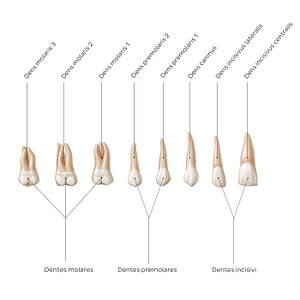Paul Kim
Overview of the teeth (Latin)
Overview of the teeth (Latin)
Dentition of quadrans maxillaris sinister in isolation with crowns (coronae) and roots (radices) visible. Each tooth has a clinical crown (corona clinica), which is the portion of the tooth seen in the oral cavity. Cusps (cuspides) are prominent landmarks on the crown presenting as eminences or projections that help teeth with their functions. The dentes canini only have a single predominant cusp, while the dentes premolares have 2 cusps except for the dens premolaris secundus mandibularis which generally has 3 cusps. The dens molaris primus mandibularis has 5 cusps whereas the dens molaris primus maxillaris has 4 cusps with a small cuspis accessorius (of Carabelli) sometimes described as a fifth cusp. Both the dentes molares secundi maxillares/mandibulares have 4 cusps. The number of roots for each tooth is similarly variable; the dentes incisivi, canini et premolares all have a single root with the exception of the dens premolaris primus maxillaris which generally has 2 roots. The dentes molares primi/secundi maxillares have 3 roots and the dentes molares primi/secundi mandibulares have 2 roots. Regarding the dentes molares tertii (a.k.a. dentes serotini), the number of cusps and roots is subject to a deal of interindividual variation, however generally varies between 3-4 cusps in the dentes molares tertii maxillares and 4-5 cusps in the dentes molares tertii mandibulares. Regarding the roots, the dens molaris tertius maxillaris varies between 1-3 roots while the dens molaris tertius mandibularis can vary between 1-2 roots.
Regular price
$7.56 USD
Regular price
Sale price
$7.56 USD
Unit price
per
Couldn't load pickup availability


#AB7A4D
#AE8257
#926438
#54463D
#E2C7AB
#CEC3B1

